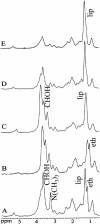Rapid identification of Candida species by using nuclear magnetic resonance spectroscopy and a statistical classification strategy
- PMID: 12902244
- PMCID: PMC169103
- DOI: 10.1128/AEM.69.8.4566-4574.2003
Rapid identification of Candida species by using nuclear magnetic resonance spectroscopy and a statistical classification strategy
Abstract
Nuclear magnetic resonance (NMR) spectra were acquired from suspensions of clinically important yeast species of the genus Candida to characterize the relationship between metabolite profiles and species identification. Major metabolites were identified by using two-dimensional correlation NMR spectroscopy. One-dimensional proton NMR spectra were analyzed by using a staged statistical classification strategy. Analysis of NMR spectra from 442 isolates of Candida albicans, C. glabrata, C. krusei, C. parapsilosis, and C. tropicalis resulted in rapid, accurate identification when compared with conventional and DNA-based identification. Spectral regions used for the classification of the five yeast species revealed species-specific differences in relative amounts of lipids, trehalose, polyols, and other metabolites. Isolates of C. parapsilosis and C. glabrata with unusual PCR fingerprinting patterns also generated atypical NMR spectra, suggesting the possibility of intraspecies discontinuity. We conclude that NMR spectroscopy combined with a statistical classification strategy is a rapid, nondestructive, and potentially valuable method for identification and chemotaxonomic characterization that may be broadly applicable to fungi and other microorganisms.
Figures


Similar articles
-
A rapid screening test to distinguish between Candida albicans and Candida dubliniensis using NMR spectroscopy.FEMS Microbiol Lett. 2005 Oct 15;251(2):327-32. doi: 10.1016/j.femsle.2005.08.016. FEMS Microbiol Lett. 2005. PMID: 16165326
-
[Evaluation of PNA-FISH method for direct identification of Candida species in blood culture samples and its potential impact on guidance of antifungal therapy].Mikrobiyol Bul. 2016 Oct;50(4):580-589. doi: 10.5578/mb.27948. Mikrobiyol Bul. 2016. PMID: 28124963 Turkish.
-
[Evaluation of peptide nucleic acid fluorescent in situ hybridization (PNA FISH) method in the identifi cation of Candida species isolated from blood cultures].Mikrobiyol Bul. 2016 Apr;50(2):293-9. doi: 10.5578/mb.22092. Mikrobiyol Bul. 2016. PMID: 27175502 Turkish.
-
Candida and candidaemia. Susceptibility and epidemiology.Dan Med J. 2013 Nov;60(11):B4698. Dan Med J. 2013. PMID: 24192246 Review.
-
Rapid identification of Candida species by FT-IR microspectroscopy.Biochim Biophys Acta. 2005 Aug 5;1724(3):239-47. doi: 10.1016/j.bbagen.2005.04.019. Biochim Biophys Acta. 2005. PMID: 15951116 Review.
Cited by
-
(1)H high resolution magic-angle coil spinning (HR-MACS) μNMR metabolic profiling of whole Saccharomyces cervisiae cells: a demonstrative study.Front Chem. 2014 Jun 12;2:38. doi: 10.3389/fchem.2014.00038. eCollection 2014. Front Chem. 2014. PMID: 24971307 Free PMC article.
-
The Role of Fatty Acid Metabolites in Vaginal Health and Disease: Application to Candidiasis.Front Microbiol. 2021 Jul 2;12:705779. doi: 10.3389/fmicb.2021.705779. eCollection 2021. Front Microbiol. 2021. PMID: 34276639 Free PMC article. Review.
-
Rapid Evaporative Ionisation Mass Spectrometry (REIMS) Provides Accurate Direct from Culture Species Identification within the Genus Candida.Sci Rep. 2016 Nov 14;6:36788. doi: 10.1038/srep36788. Sci Rep. 2016. PMID: 27841356 Free PMC article.
-
Recent trends in molecular diagnostics of yeast infections: from PCR to NGS.FEMS Microbiol Rev. 2019 Sep 1;43(5):517-547. doi: 10.1093/femsre/fuz015. FEMS Microbiol Rev. 2019. PMID: 31158289 Free PMC article. Review.
-
Biology of the pathogenic yeast Candida glabrata.Folia Microbiol (Praha). 2006;51(1):3-20. doi: 10.1007/BF02931443. Folia Microbiol (Praha). 2006. PMID: 16821705 Review.
References
-
- Botha, A., and J. L. F. Kock. 1993. Application of fatty acid profiles in the identification of yeasts. Int. J. Food Microbiol. 19:39-51. - PubMed
-
- Bubb, W. A., L. C. Wright, M. Cagney, R. T. Santangelo, T. C. Sorrell, and P. W. Kuchel. 1999. Heteronuclear NMR studies of metabolites produced by Cryptococcus neoformans in culture media: identification of possible virulence factors. Magn. Reson. Med. 42:442-453. - PubMed
Publication types
MeSH terms
LinkOut - more resources
Full Text Sources

